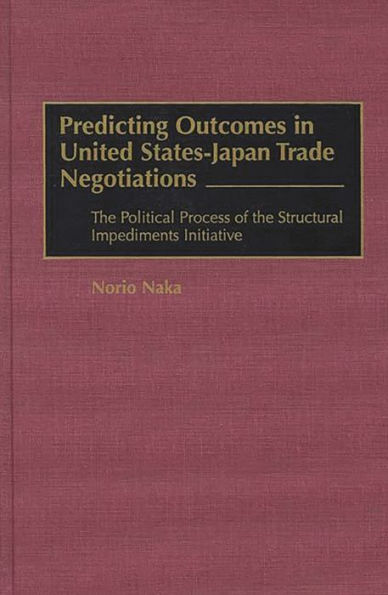5
1

Predicting Outcomes in United States-Japan Trade Negotiations: The Political Process of the Structural Impediments Initiative
296
by Norio Naka
Norio Naka

Predicting Outcomes in United States-Japan Trade Negotiations: The Political Process of the Structural Impediments Initiative
296
by Norio Naka
Norio Naka
Hardcover
$95.00
-
PICK UP IN STORECheck Availability at Nearby Stores
Available within 2 business hours
Related collections and offers
95.0
In Stock
Overview
The U.S.-Japan Structural Impediments Initiative (SII) was an attempt in which U.S. and Japanese officials tried to solve trade frictions and adjust their economic systems both by creating an international epistemic community and regime and by accelerating domestic structural change through a joint bureaucratic structure (working group) and mutual pressure. With four multidimensionally-layered conceptual models, the book systematically describes and explains the political process of the SII, the reasons for its initiation and reaching agreements. Unlike most studies on U.S.-Japan trade negotiations which use the theoretically undefined case study method, the author tested propositions focussing on different factors (level of U.S. pressure, size and strength of various transgovernmental coalitions, and level of perception gaps) for different degrees of Japanese trade concessions across five SII issue areas (saving-investment patterns, the distribution system, exclusionary business practices, land policy, and keiretsu) by combining a detailed case study with content analysis of newspaper indexes and meeting records. The book adds to the tradition of U.S.-Japan trade negotiation/decision-making research with great insights and practical implications. It further develops Graham Allison's approach, applying it to international trade negotiation process, thereby enhancing the power of describing, explaining, and predicting outcomes of international trade negotiations. Intended for graduate students and specialists studying U.S.-Japan trade negotiations as well as policymakers practicing such negotiations.
To know why and how the SII was initiated and agreed upon and what factors contributed to different degrees of Japanese trade concessions, four multidimensionally-layered conceptual models systematically describe and explain the political process of the SII. Unlike most studies on U.S.-Japan trade negotiations which use the theoretically undefined case study method, the author tested different propositions for different degrees of Japanese trade concessions across five SII issue areas by combining a detailed case study with content analysis of newspaper indexes and meeting records. The book adds to the tradition of U.S.-Japan trade negotiation/decision-making research. It further develops Graham Allison's approach, applying it to the international trade negotiation process, thereby enhancing the power of describing, explaining, and predicting outcomes of international trade negotiations. Intended for graduate students and specialists studying U.S.-Japan trade negotiations as well as policy-makers practicing such negotiations.
To know why and how the SII was initiated and agreed upon and what factors contributed to different degrees of Japanese trade concessions, four multidimensionally-layered conceptual models systematically describe and explain the political process of the SII. Unlike most studies on U.S.-Japan trade negotiations which use the theoretically undefined case study method, the author tested different propositions for different degrees of Japanese trade concessions across five SII issue areas by combining a detailed case study with content analysis of newspaper indexes and meeting records. The book adds to the tradition of U.S.-Japan trade negotiation/decision-making research. It further develops Graham Allison's approach, applying it to the international trade negotiation process, thereby enhancing the power of describing, explaining, and predicting outcomes of international trade negotiations. Intended for graduate students and specialists studying U.S.-Japan trade negotiations as well as policy-makers practicing such negotiations.

Product Details
| ISBN-13: | 9781567200058 |
|---|---|
| Publisher: | Bloomsbury Academic |
| Publication date: | 04/18/1996 |
| Pages: | 296 |
| Product dimensions: | 6.14(w) x 9.21(h) x 0.69(d) |
| Lexile: | 1750L (what's this?) |
About the Author
NORIO NAKA is a visiting fellow at the Center for Japanese Studies, University of California, Berkeley. Until recently he was a Post-Doctoral Scholar at Purdue University. A specialist in the political economy of U.S.-Japan trade relations and organizational development, Dr. Naka is the author of several jourbanal articles.
Table of Contents
PrefaceAbbreviations
Introduction
Overview of SII Process and its Agreements
Theoretical Framework and Research Design
The SII as a Means of Gaiatsu: The Perspective of Government as a Unitary Rational Actor
Quantification of Interactions between Governments: Pressures and Negotiations
The SII as a Site of the Transgovernmental Coalition of Subunits
The U.S. Agencies' Concerns: Content Analysis of the SII Meeting Records
The SII as Part of a Transgovernmental Coalition among Top-level Policy-Makers
The SII as Part of a Transgovernmental Elite Policy Networks of Working-Level officials
Conclusion: Findings and Implications
Appendix A: Tables
Appendix B: The Coding Method for "Performative Structure" Content Analysis
Appendix C: The Coding Method of Key-Word Content Analysis
Bibli1ography
Index
From the B&N Reads Blog
Page 1 of
